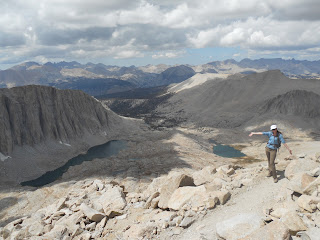In my last post, I spelled out the pros and cons of the single-day summit. While I am biased towards that method, I understand the reasons why people want to do the trip as a multi-day backpack. However, lack of training and preparation are not valid reasons for a multi-day attempt. If anything, a successful multi-day trip requires more preparation than the already stiff requirements for a successful single-day summit.

Read warning labels before use

The Multi-Day Main Trail Backpack:
- Pro: More permit latitude. A multi-day-er has 14 days to get her done on the same permit provided we declare our intention to do so on the application and stay inside the Mt Whitney Zone. Our permit "day" references the date we enter the John Muir Wilderness, about .9 miles from the trailhead at Whitney Portal. That's because the permit also covers camping at Lone Pine Lake, just before the Mt whitney Zone starts. If the weather turns for the worse, we can hunker down (safely!) and wait until it blows over. Then we try again the next day from either Outpost or Trail Camp provided you made allowances for extra days and the provisions hold out. Don't worry. No one will arrest you if you come out early or late. The USFS understands the vagaries of mountain travel. Weather or injury can alter your schedule.
- Pro: Visit more stuff. Since the permit can last 14 days, design a comprehensive trip to visit all the interesting topography in the basin or bag another local Fourteener like Mt Muir (approach from Trail Crest). I've always wanted to visit the plateau north of the switchbacks. It looks like the Moon.
- Con: Acclimatization becomes even more important. Again, it's one thing to visit high altitudes and a whole 'nother smoke to stay overnight. Contrary to popular belief, there are no shortcuts to proper acclimatizing. Take all the Diamox you want. The side effects are altered sense of taste, drowsiness, dizziness, nausea, vomiting, increased sunlight sensitivity...wait a minute. Sounds a lot like altitude sickness. At least we can cure altitude sickness by going back down.
- Con: Contributing to "The Sewer." The longer one stays in
the Whitney Zone, the more likely one needs to relieve oneself. Since the
solar toilets were removed, the amount of poo near the trail and the
camps increased dramatically, especially since many people refuse to
adhere to mandatory Leave No Trace ethics and pack it out. Therefore, I
refer to Lone Pine Creek as The Sewer.
Don't even think about drinking that water without filtration. Don't even think about digging a hole and burying waste, either. Wherever you dig, someone already beat you to it. "Wag Bags" are issued at the Eastern Sierra Interagency Center with every permit. Purchase additional bags at your local backpacking retailer. Take one apart with your group. See how it works. You may not have time to read directions when The Urge strikes. If packing out your waste is beyond your ability, please stay home. Please.The World's Loveliest Sewer - Con: Increased exposure to objective dangers. Violent bad weather, high wind gusts, and rockfall take their toll. More hours up high mean greater exposure. If I owned a $400 Supercalifragilistic Ultralight Goat Bladder Mark III tent, seeing it in tatters would make me cry.
Having said that, some climbers want the "expedition assault" feel of a multi-day trip with gear. If that's your bent, consider a real multi-day adventure jumping off from Horseshoe Meadows or the High Sierra Trail all the way across Sequoia National Park. By the time you approach Mt Whitney proper, you'll be much better acclimated than trying to blitz all the weight up and down quickly.
If you're looking to spend lots of time in the Whitney Zone knocking out every prominent knob in the area, then the Main Trail multi is unavoidable. However, don't short-change your conditioning or acclimatizing. Remember this old saying: Climbers summiting Whitney from the west are the ones with smiles on their faces. Climbers summiting from the east are the ones throwing up on their shoes.














